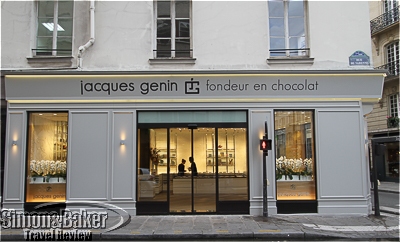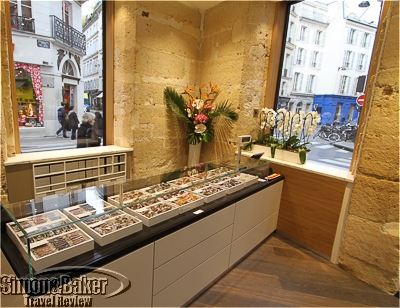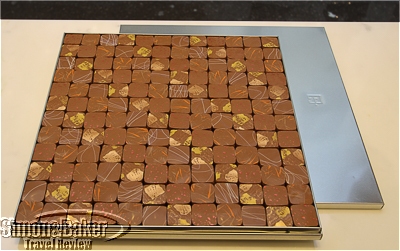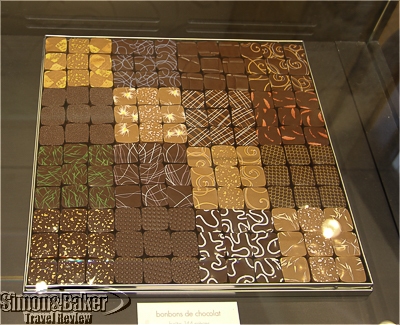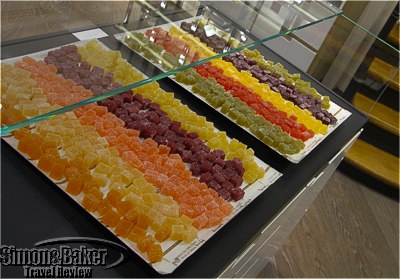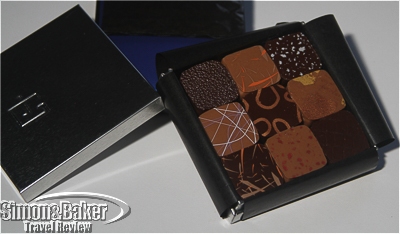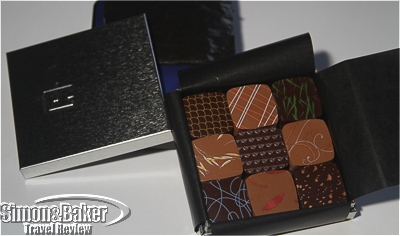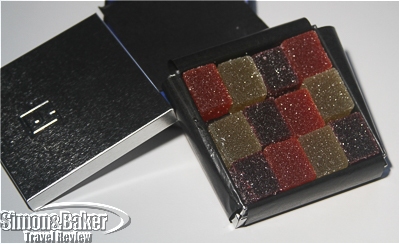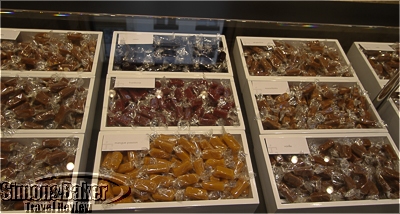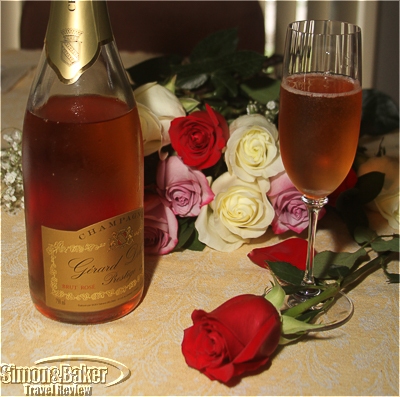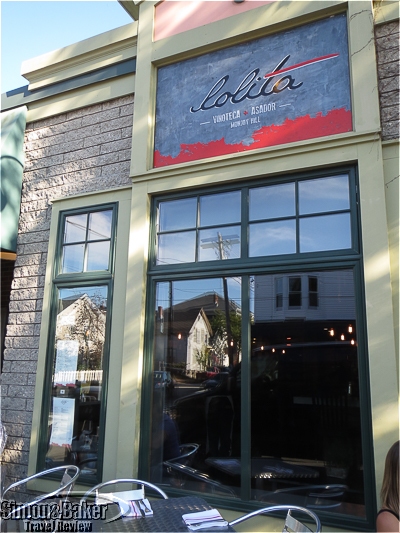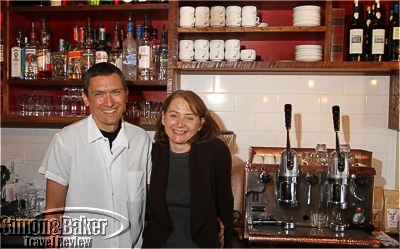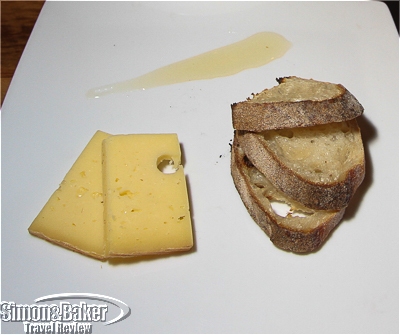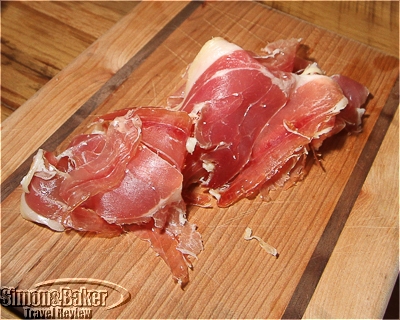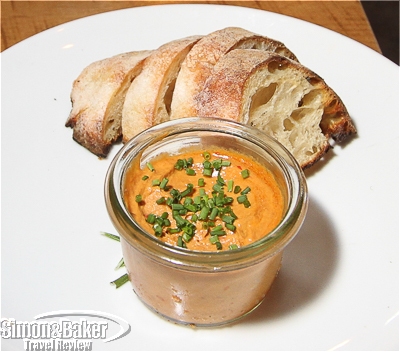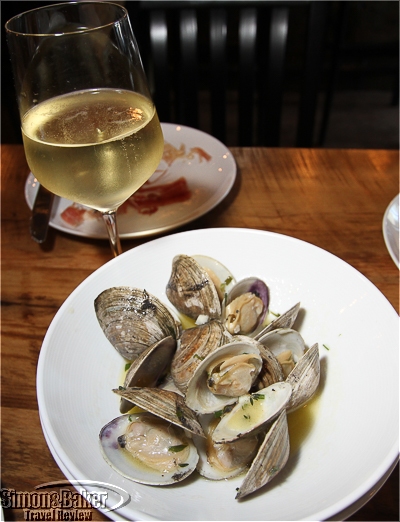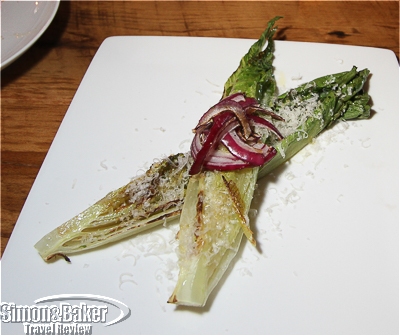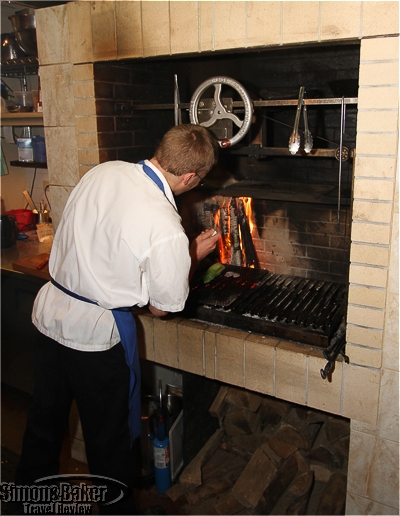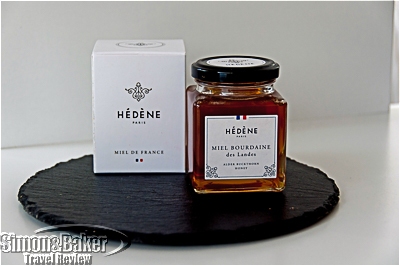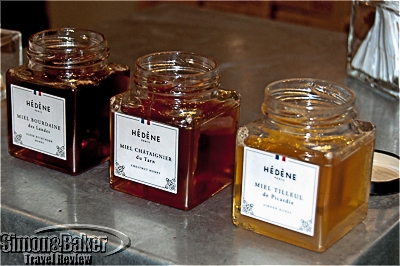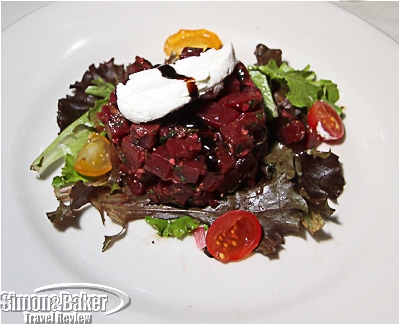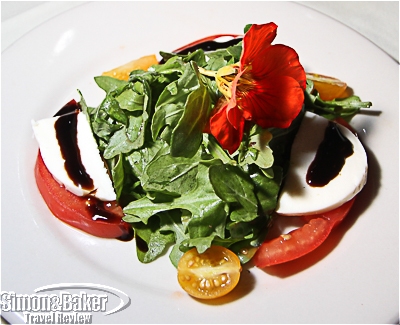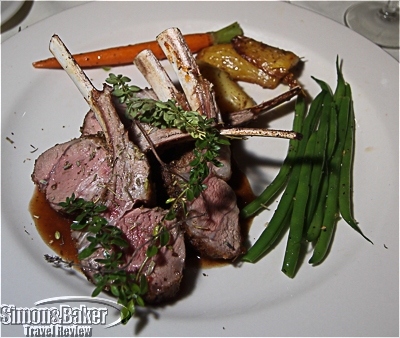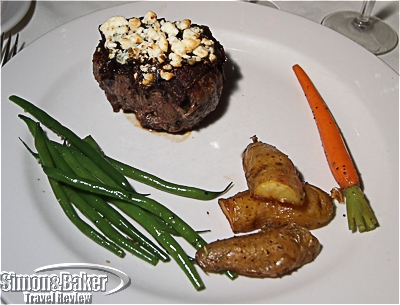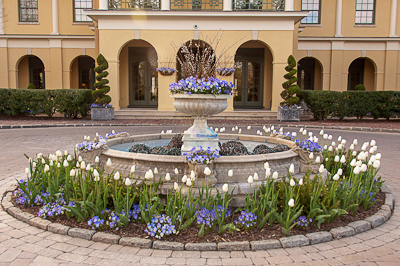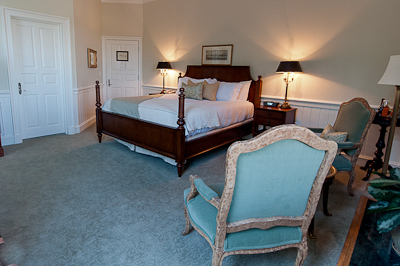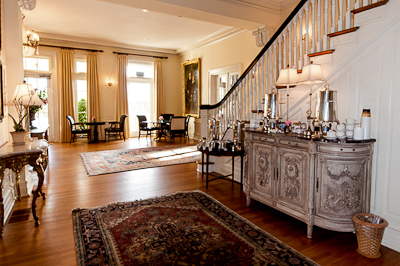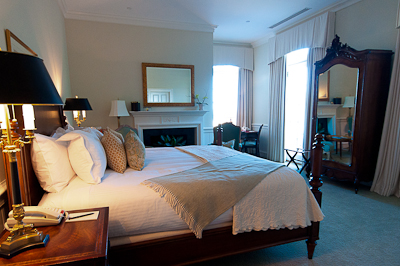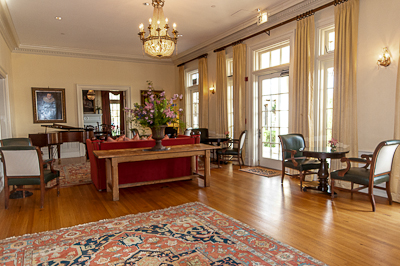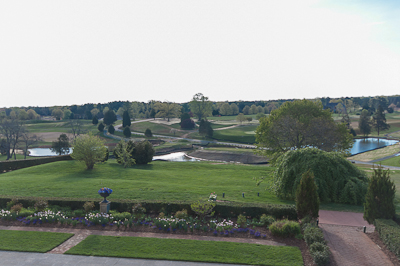Luxury Travel Review

Paris chocolate, candy maker opened new Left Bank shop
By Elena del Valle
Photos by Gary Cox
The exterior of the Left Bank shop
About two years ago we visited the Jacques Genin, fondeur en chocolat factory and shop in the Right Bank of Paris, France (Passionate chocolate, candy maker draw to Paris Marais shop) where we met the enthusiastic chocolate and candy maker and tasted some of his creations. Recently, we visited his new 80 square meter Left Bank corner shop (27 rue de Varenne, 75007 Paris, France,+33 1 53 71 72 21, www.jacquesgenin.fr) and carried home goodies to taste. We liked that they were made fresh at the Jacques Genin factory in Paris from all natural ingredients.
Flowers and large windows made the shop bright and cheerful – click to enlarge
The brightly lit spacious shop was a treasure trove of candy, displayed behind elegant glass topped cases. It occupied a prominent corner in the well heeled seventh arrondissement.
A box of milk chocolates – click to enlarge
Distinctive markings formed designs that identified the various flavors – click to enlarge.
Fruit and vegetable candies added a touch of color – click to enlarge.
Once again we were delighted with the fragrant and delicate flavors in his bite size chocolates which had to be consumed within a week. A distinctive pattern or design on each chocolate was useful in identifying the filling by referring to a card the staff provided with our two boxes of nine chocolates each. Three types of chocolate were described in French on the card as well as candy like the caramels and pates de fruit flavors. There were three main categories of chocolate: dark, milk and praline. The praline was available in dark and milk chocolate flavors. Among the flavors we sampled was dark chocolate chestnut honey, dark chocolate mint and almond, dark chocolate praline, dark chocolate almond praline and milk chocolate hazelnut praline. We were unable to identify all of the flavors.
The chocolate and pate de fruit came in the distinctive square metallic boxes we recognized from our previous visits to the chocolate shops. We tasted some of the products from his new line of pates de fruits vegetable candy made from seasonal produce such as turnip, beetroot, carrot, celery, fennel, sweet pepper, and cucumber. While we appreciate their special nature they were not favorites. The next time we visit one of his shops, we’ll revert back to the fruit candy we have enjoyed in the past.
The box of chocolates and praline we tried – click to enlarge
The box of chocolates we tried – click to enlarge
The box of the new vegetable Pate de fruit we tried
Caramels in a variety of flavors were on display in the Left Bank shop.
We also tried several caramels including the popular passion fruit as well as blackcurrant, raspberry, honey, almond, and salt butter. They were outstanding.
Happy New Year!
Promising new tapas wine and grill eatery in Portland, Maine
By Elena del Valle
Photos by Gary Cox
The exterior of Lolita Vinoteca + Asador
Lolita Vinoteca + Asador (90 Congress Street, Portland, Maine 04101, +1 207-775-5652, http://www.lolita-portland.com/, info@lolita-portland.com), a few blocks past the Portland Observatory on one of Portland’s main streets, was easy to find. Maine’s coastal city had many dining choices from exotic to exclusively local. Lolita, established by Guy (executive chef) and Stella Hernandez and Neil Reiter was the only Spanish themed tapas eatery with a wood fired oven we came across. The 900 square foot eatery with a staff of 12, table seating for 20, and space for 10 at the bar opened its doors in June 2014.
Guy and Stella Hernandez
The menu, described as “American cuisine, guided by Mediterranean and old-world traditions,” featured small plates and plates to share with specialty dishes from the wood-fired grill and meats from the eatery’s antique prosciutto slicer.
Bread, honey and Consider Bardwell cheese
Prior to Lolita, Guy and Stella owned and operated Bar Lola for seven years. Lolita is a reference to that previous establishment in that the Asador where we had lunch was smaller and less structured than Bar Lola had been. Vinoteca, or wine facility in Spanish, referred to Stella’s wine and beverage background. There was a list of 75 wines featuring classic wine regions and varietals, as well as unique selections from around the world. Plans were in place for an extensive by-the-glass program with full, half-glass and flights options. Asador, referring to an establishment that features food cooked over an open fire in Spanish, highlighted the custom grill in the open kitchen.
A serving of thinly sliced Serrano ham
Before entering the restaurant industry, Guy held a number of teaching positions in architectural design and technical drawing. In 2006, before opening Bar Lola, Guy was a baker at the One Fifty Ate Bakeshop in South Portland, and assisted with the launch of Scratch Baking.
Stella, general manager and beverage director at Lolita, had more than a decade of experience in the hospitality industry. Prior to working at Lolita, she held the same positions for Bar Lola. She was a member of the Guild of Sommeliers and was taking Court of Master Sommeliers education courses. Stella and Guy were the owners of Hilltop Coffee, nearby.
The Sardine Rillette pot with bread
Neil’s passion for the restaurant industry grew out of his experience as a silent partner in several successful New York City restaurants and clubs. Previous entrepreneurial experiences included founding and being president of Reiter Marketing Group, Inc., and R & J Partners, LLC.
Our order of Wood Roasted Clams
We liked the casual contemporary decor with post industrial features, as well as the friendly and well informed, if slow paced, service. Mostly we enjoyed the food. We sampled a variety of the dishes: Thinly sliced Serrano ham from La Alberca, Spain; the day’s special short rib panino; Consider Bardwell, a West Pawlet, Vermont cheese; local Wood Roasted Clams (a favorite); Spicy Sardine Rillette, served in a pot with roasted slices of bread; Grilled Romaine served with Tarragon Vinaigrette and Pecorino cheese shavings (a favorite); and a homemade Apple Tarte Fine for two. We washed it down with a glass of cava and a pale ale.
The Grilled Romaine
One of the staff making Grilled Romaine in the Asador
Our only complaint? Parking was difficult to find in the residential neighborhood of Munjoy Hill. It took us ten or more minutes of circling around the eatery to locate a parking space two blocks away where we hoped our car would be safe from the tow trucks announced on many city signs.
Monofloral honeys bring diverse regional essences of France to the table
Article and photos by Josette King
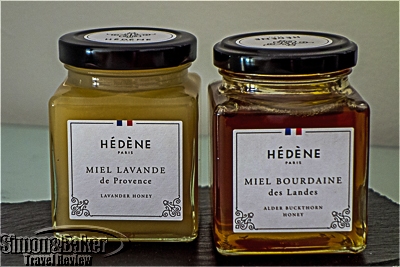
Signature Hédène cube jars were a common site on the shelves of gourmet shops
“Please hand me the rosemary honey,” my friend asked. I was wedged in a corner of her diminutive Paris kitchen where she was whipping up an impromptu dinner while we caught up after a long separation. “Honey in the vinaigrette?” I thought as I reached on the shelf above my head for a cube-shaped jar filled with rich amber liquid. “The rosemary,” she insisted, “the light one.” I glanced at the jar in my hand. A smart white label announced “Hédène Miel Sapin du Jura” (Jura Mountains Fir Honey). I reached up again for an identical jar, that one filled with a silvery concoction. “That’s lavender,” she said absentmindedly, arm stretching above me to retrieve a third jar just a notch darker, a pale champagne color. I couldn’t resist asking: “why do you need all this honey?”
“This is not just honey,” she pointed out, “it’s pure monofloral honey. The right one can do wonders for just about any dish. Smell it.” Having just branded myself a honey philistine, I inhaled the “Lavande de Provence.” It had a delicate, complex scent that took me back to warm Provencal evenings. “We’ll have it for dessert,” she volunteered, “drizzled over mixed red berries and yogurt.” By now I was taking a whiff of “Sapin du Jura.” It did hint at a walk in an evergreen forest. “We’ll try it for breakfast tomorrow; on pain perdu (French toast). Think of maple syrup, only much more subtle, with an elegant lingering palate.” I felt we had just crossed into the elite spheres of wine tasting.
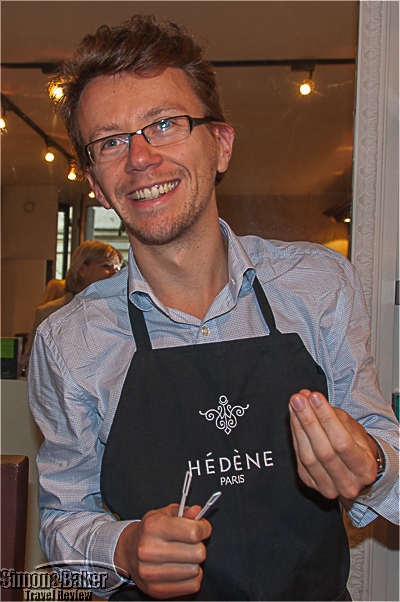
Cyril Marx explaining the finer points of monofloral beekeeping
This impression was confirmed a couple of weeks later when I attended an Hédène honey tasting at a Latin Quarter gourmet shop (86 rue de l’Université, 75007 Paris, France, +33 6 63 04 98 82 86, http://www.hedene.fr/en/, contact@hedene.fr ). I immediately spotted my three old acquaintances Sapin du Jura, Lavande de Provence and Romarin du Languedoc among a display of the signature cubes with their tailored white labels and black tops. The collection also included Acacia de Bourgogne (Burgundy Acacia Honey), Tilleul de Picardie (Picardy Linden Honey) and Châtaignier du Tard (Tarn Valley Chestnut Honey), lined in a palette ranging from the palest of golds to rich copper.
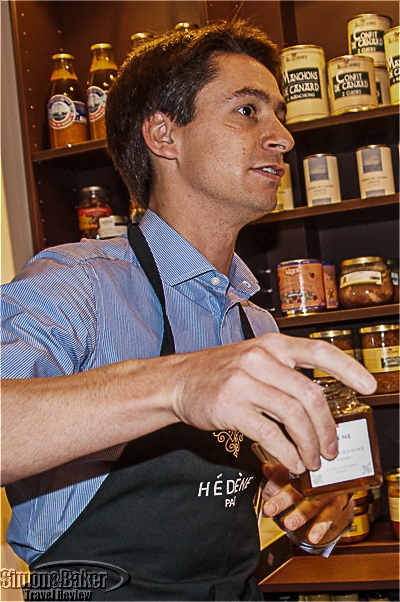
Alexis Ratouis conducting a tasting of Hédène honeys
But mostly I met the two enthusiastic young men clad in matching dark grey aprons, who were orchestrating the proceedings, Cyril Marx and Alexis Ratouis, the cofounders of Hédène, a brand of premium French monofloral artisan honeys created in 2013; and I got the answer to my unspoken question: what makes Hédène honeys so special that they have already garnered preeminent space on the shelves of épiceries fines (gourmet shops) throughout France; and gained staple status in the pantry of my Parisian gourmet friend?
The newly introduced Bourdaine des Landes was the star of the honey tasting (click to enlarge)
Cyril and Alexis met at university in Paris and developed a friendship based on common interests including apiculture. Cyril’s family has kept hives in the Cevennes for four generations, while Alexis’ relatives keep their own bees in Savoy. Both men have enjoyed participating in honey harvests since childhood. Even as they completed their education and began their professional careers, they nurtured their passion for apiculture at le Rucher Ecole du Jardin du Luxembourg (founded in 1856, the Luxembourg Garden Hive is recognized as the oldest ongoing urban hive in France, and one of its most prestigious apicultural teaching institutions). After two years of intense planning, they decided to make it their career. Hédène was launched that year.
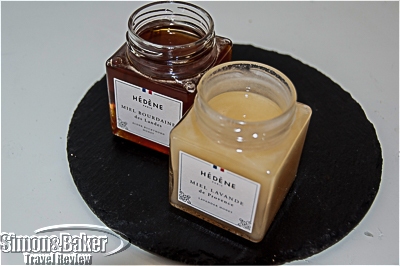
My current Hédène favorite French monofloral honeys
“We aim to take our customers on a journey of the diverse regions of France. All our honeys are unique monofloral vintages issued from a flower characteristic of its area of origin, each with its distinctive color, taste and texture,” Cyril explained.
In each area, they select artisans who uphold the highest standards of traditional beekeeping. Those chosen suppliers also commit to adhering to the rigorous specifications set by Hédène. But how do they ensure that the bees will make single flower honey? The selected beekeepers in areas where the target plant predominates must time the introduction of the hive and the actual harvesting of the comb to coincide with the peak blooming period. To be chosen as an Hédène product, the honey must be analyzed and laboratory certified to contain the required pollens.
Because of these rigorous requirements, as in the world of fine wines, the quantities of an especially prized vintage may be limited.
Hédène monofloral honeys ready for tasting (click to enlarge)
It was the case with the Miel Bourdaine des Landes (Adler Buckthorn Honey from the southwestern France Atlantic coast) being introduced that day. It was the color of fine Cognac, full bodied with a delicately astringent, quince-like finish. There will be no more than 2,000 jars available this fall, and with the holiday gifting season coming up I doubted they would last long on the market. I immediately purchased two jars, one for my honey connoisseur friend, the other one for myself. I can’t wait to hear what she thinks of it. As for me, I expect it will be delicious as a glaze for roasted pork tenderloin. And by the way, that tablespoon of Miel Romarin du Languedoc did work wonders for the vinaigrette on our mixed summer’s greens salad.
A pleasant French style dinner in Lincolnville, Maine
By Elena del Valle
Photos by Gary Cox
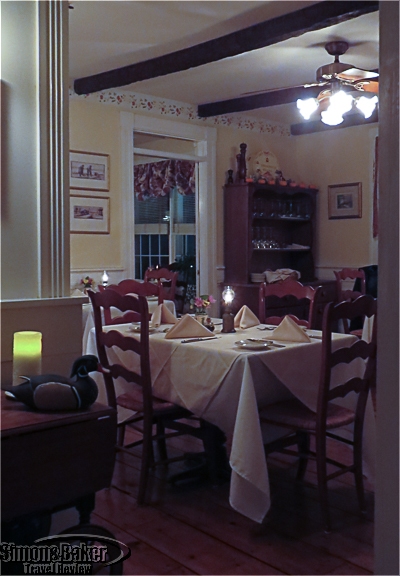
The restaurant in the Youngtown Inn
We arrived hungry at the Youngtown Inn and Restaurant in Lincolnville, Maine, after a day of driving and tourist activities with little time for lunch. Instead of driving the six miles from our nearby inn we opted for a taxi. Fortunately, it was early when we asked if the restaurant was near enough to walk. A smiling front desk staff person indicated it would be better to drive or rely on a transport service as it was several miles away down dark roads. Advance planning was necessary as it required 25 minutes before a taxi made its way to Linconlville Beach, where we were staying, from its base of operations in Rockport. It was the only taxi service available, the staff woman explained.
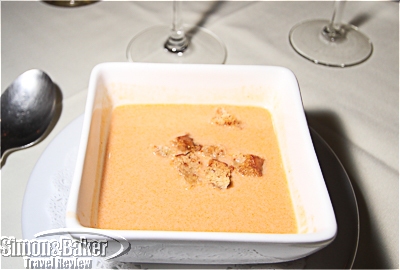
The lobster bisque
As the taxi van negotiated the dark residential roads and our tiredness sunk in we were glad of our decision. As we entered the restaurant, located within a classic 1810 farmhouse turned into a cozy four room inn, a distracted middle aged woman welcomed us, led us to our table and handed us menus. We explained that we needed a taxi and she offered to call the service when our dessert arrived. As the evening wore on her timing estimate proved to be spot on. Moments later, another personable woman arrived to announce the daily specials and bring us water. Although it was a weekend evening we were among few guests at the restaurant because of a nearby special event.
Our beet salad (click to enlarge)
The arugula salad was garnished with a flower (click to enlarge)
While the set menu was well priced, the chef’s beef and lamb specialties were on only offer in the a la carte menu so we chose that one. There were two types of bread, whole wheat and sour dough. For starters we ordered Lobster Bisque with Sherry made with fresh lobster chunks, one beet salad and one arugula salad. For mains we had Pan Seared Black Angus Filet Mignon, Caramelized Onions, Roquefort and Roast Rack of Imported Lamb with Herbs de Provence (a favorite) both of which were well prepared. They were served with green beans, carrots and potatoes. Relying on our server’s advice we ordered a 2010 Billerond Saint Emilion to accompany our dinner. It was a good match for the meal, stout enough for the red meats yet well rounded and with a smooth finish.
The lamb was moist and tasty (click to enlarge)
The filet mignon with the pepper sauce removed
Although the menu description of my filet mignon said nothing about pepper nor did the server mention it when I placed my order, the meat was sitting atop and covered in a thick black pepper sauce. After I raised the issue, the server took it back to the kitchen where they removed the sauce. She brought it back quickly and it was still hot, but the pepper flavor had penetrated the meat, making it difficult to enjoy my dish or taste the Roquefort cheese.
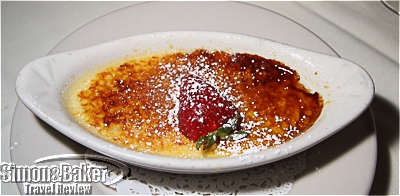
The creme brulee
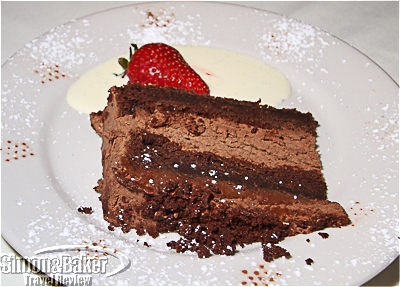
The chocolate truffle cake
For dessert we had Tahitian bean Creme Brulee and Chocolate Truffle Cake. While the thin slice of cake didn’t look especially appetizing it had a rich chocolate flavor. Dinner was pleasant. The Youngtown Inn and Restaurant, 581 Youngtown Road, Lincolnville, Maine 04849, +1 207-763-4290, info@youngtowninn.com
Forgotten Italianate villa back to life as world class Virginia boutique hotel
Article and photos by Josette King
The formal arched central entrance of Keswick Hall
It is not unusual for friends who know that I am “always running off somewhere” to ask about my personal “short list” of favorite properties around the world; and be surprised that the list is quite short, of properties so exceptional in their location, surrounding, facilities, accommodations and service that I would gladly fly half way around the world to enjoy them again. On my recent visit to Charlottesville, Virginia I had the pleasure of adding one entry to my list, Keswick Hall.
The infinity swimming pool acted as a reflecting pool for the north facade of the villa
The elegant Italianate mansion located on 600 acres (243 hectares) of pristine countryside at the eastern edge of the city had the feel of a grand English country estate. As I drove around the circular driveway to the formal triple archway of the central entrance, I fleetingly wondered whether the walking shoes and jeans in which I had roamed all day from area wineries to remote artist studios were appropriate for the occasion. But already, the doorman was making me welcome like a long expected friend of the family. My luggage was out the trunk and my dusty rented car whisked away by the time I stepped through the open door into my “great uncle’s country mansion.”
My room was a welcoming retreat of understated elegance
It was just as Sir Bernard Ashley intended when in 1991 he set out to transform the decaying Italianate Villa Crawford into a world class property where guests would feel they were staying at a private manor house. Three years and a $25 million major restoration and expansion effort later, he had created Keswick Hall.
The historic North Wing had reclaimed its original opulence
In the central grand entrance hall, mellow oriental rugs created intimate spaces for clusters of inviting sofas, armchairs and antique accents furniture. Fresh flowers, in seemingly simple arrangement hinted at having been brought from the garden on a whim by an artistically minded lady of the house.
An antique mirrored armoire was a focal point of my room
In spite of its vast proportions, the room had a lived in feel, as though it had organically developed to its current gracious state through generations of residents. I had to remind myself to look for the reception area. It was there, an inconspicuous desk in the corner nearest to the entrance, as was the concierge desk, in the opposing corner of the hall. Both were staffed with knowledgeable and attentive hosts who appeared ready to assist with even the smallest of wishes. This was the norm for any staff member with whom I came in contact.
The North Wing sitting room
My own accommodations were equally welcoming, a large light filled room decorated in a relaxing neutral palette and a mix of antiques and period inspired furniture, and a French door that opened onto a large corner terrace with views of the garden and the manicured vistas of the golf course. Fossett’s, the property’s award winning restaurant, was remarkable not only for the quality of its classic continental cuisine with Virginia flair, but for it panoramic views of the estate’s rolling hills and the Blue Ridge Mountains beyond.
The lower terrace of the mansion reached out the rolling lawns at the rear of the estate
In addition to its flawless hospitably, Keswick Hall offered activities to indulge the most varied tastes, from the billiard room restored in the original Villa Crawford, now the Historic North Wing of the mansion, to an in-house spa, a croquet pitch overlooking the Southwest Mountains, spectacular 18 hole golf course, nature walk and bird watching trails, aquatic center and tennis courts. It even had its own courtside vineyard. But for me, the ultimate luxury was the Horizon Pool, the adults only, heated saltwater infinity pool that reflected the north façade of the mansion. Best of all, it was open around the clock.

